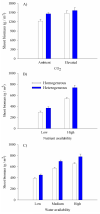Plant responses to soil heterogeneity and global environmental change
- PMID: 25914423
- PMCID: PMC4407979
- DOI: 10.1111/j.1365-2745.2012.02014.x
Plant responses to soil heterogeneity and global environmental change
Abstract
Recent evidence suggests that soil nutrient heterogeneity, a ubiquitous feature of terrestrial ecosystems, modulates plant responses to ongoing global change (GC). However, we know little about the overall trends of such responses, the GC drivers involved, and the plant attributes affected.We synthesized literature to answer the question: Does soil heterogeneity significantly affect plant responses to main GC drivers, such as elevated atmospheric carbon dioxide concentration (CO2), nitrogen (N) enrichment and changes in rainfall regime?Overall, most studies have addressed short-term effects of N enrichment on the performance of model plant communities using experiments conducted under controlled conditions. The role of soil heterogeneity as a modulator of plant responses to elevated CO2 may depend on the plasticity in nutrient uptake patterns. Soil heterogeneity does interact with N enrichment to determine plant growth and nutrient status, but the outcome of this interaction has been found to be both synergistic and inhibitory. The very few studies published on interactive effects of soil heterogeneity and changes in rainfall regime prevented us from identifying any general pattern.We identify the long-term consequences of soil heterogeneity on plant community dynamics in the field, and the ecosystem level responses of the soil heterogeneity × GC driver interaction, as the main knowledge gaps in this area of research.In order to fill these gaps and take soil heterogeneity and GC research a step forward, we propose the following research guidelines: 1) combining morphological and physiological plant responses to soil heterogeneity with field observations of community composition and predictions from simulation models; and 2) incorporating soil heterogeneity into a trait-based response-effect framework, where plant resource-use traits are used as both response variables to this heterogeneity and GC, and predictors of ecosystem functioning.Synthesis. There is enough evidence to affirm that soil heterogeneity modulates plant responses to elevated atmospheric CO2 and N enrichment. Our synthesis indicates that we must explicitly consider soil heterogeneity to accurately predict plant responses to GC drivers.
Keywords: CO2, changes in rainfall regime; N enrichment; community-level studies; ecosystem functioning; global change; plant performance; plant-soil interactions; root foraging; soil nutrient heterogeneity.
Figures



Similar articles
-
Soil nutrient heterogeneity modulates ecosystem responses to changes in the identity and richness of plant functional groups.J Ecol. 2011 Mar 1;99(2):551-562. doi: 10.1111/j.1365-2745.2010.01765.x. J Ecol. 2011. PMID: 25914424 Free PMC article.
-
Interactive effects of plant species diversity and elevated CO2 on soil biota and nutrient cycling.Ecology. 2007 Dec;88(12):3153-63. doi: 10.1890/06-2100.1. Ecology. 2007. PMID: 18229849
-
Response of plant functional traits to nitrogen enrichment under climate change: A meta-analysis.Sci Total Environ. 2022 Aug 15;834:155379. doi: 10.1016/j.scitotenv.2022.155379. Epub 2022 Apr 20. Sci Total Environ. 2022. PMID: 35460775
-
[Response of fine roots to soil nutrient spatial heterogeneity].Ying Yong Sheng Tai Xue Bao. 2004 Jun;15(6):1063-8. Ying Yong Sheng Tai Xue Bao. 2004. PMID: 15362636 Review. Chinese.
-
Links across ecological scales: Plant biomass responses to elevated CO2.Glob Chang Biol. 2022 Nov;28(21):6115-6134. doi: 10.1111/gcb.16351. Epub 2022 Sep 7. Glob Chang Biol. 2022. PMID: 36069191 Free PMC article. Review.
Cited by
-
Artemisia smithii patches form fertile islands and lead to heterogeneity of soil bacteria and fungi within and around the patches in alpine meadows of the Qinghai-Tibetan Plateau.Front Plant Sci. 2024 Jun 28;15:1411839. doi: 10.3389/fpls.2024.1411839. eCollection 2024. Front Plant Sci. 2024. PMID: 39006955 Free PMC article.
-
Plant Clonal Integration Mediates the Horizontal Redistribution of Soil Resources, Benefiting Neighboring Plants.Front Plant Sci. 2016 Feb 5;7:77. doi: 10.3389/fpls.2016.00077. eCollection 2016. Front Plant Sci. 2016. PMID: 26904051 Free PMC article.
-
Species richness alters spatial nutrient heterogeneity effects on above-ground plant biomass.Biol Lett. 2017 Dec;13(12):20170510. doi: 10.1098/rsbl.2017.0510. Biol Lett. 2017. PMID: 29237812 Free PMC article.
-
The Effect of Nitrogen Deposition on Plant Performance and Community Structure: Is It Life Stage Specific?PLoS One. 2016 Jun 2;11(6):e0156685. doi: 10.1371/journal.pone.0156685. eCollection 2016. PLoS One. 2016. PMID: 27253718 Free PMC article.
-
Determining the role of richness and evenness in alpine grassland productivity across climatic and edaphic gradients.Oecologia. 2022 Dec;200(3-4):491-502. doi: 10.1007/s00442-022-05279-5. Epub 2022 Nov 4. Oecologia. 2022. PMID: 36333613
References
-
- Ackerly DD, Cornwell WK. A trait-based approach to community assembly: partitioning of species trait values into within- and among-community components. Ecology Letters. 2007;10:135–145. - PubMed
-
- Arnone JA., III Temporal responses of community fine root populations to long-term elevated atmospheric CO2 and soil nutrient patches in model tropical ecosystems. Acta Oecologica. 1997;18:367–376.
-
- Baer SG, Blair JM, Collins SL, Knapp AK. Plant community responses to resource availability and heterogeneity during restoration. Oecologia. 2004;139:617–639. - PubMed
-
- Bakker C, Blair JM, Knapp AK. A comparative assessment of potential mechanisms influencing plant species richness in grazed grasslands. Oecologia. 2003;137:385–391. - PubMed
-
- Balzter H, Braun PW, Köhler W. Cellular automata models for vegetation dynamics. Ecological Modelling. 1998;107:113–125.
Grants and funding
LinkOut - more resources
Full Text Sources
Miscellaneous
